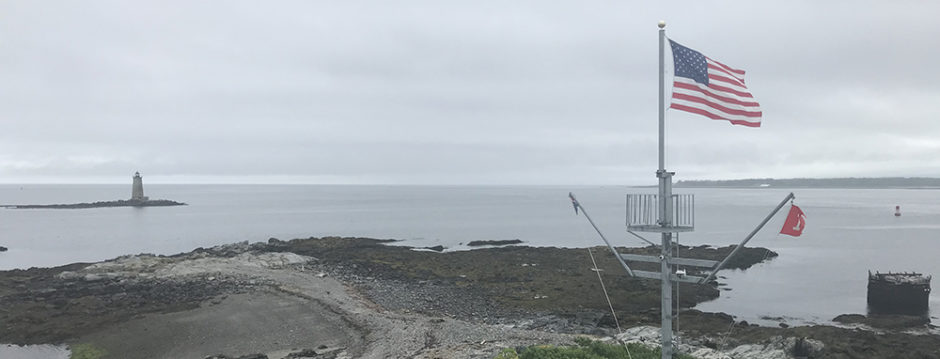On that morning after the ice storm, I left my chilly powerless house to warm up in the forests of Mount Agamenticus. My goal: to hunt down a tiny aphid-like insect, the woolly adelgid, that kills hemlock trees.
I had volunteered to monitor a patch of forest below the mountain, a project organized by the Maine Forest Service to stop the spread of this invasive pest, which, if left unchecked, kills hemlock trees. In the forests of North Carolina, Virginia and other states, large stands of hemlock have died off, their evergreen foliage replaced with grey brittle needles.
I went to the woods that December morning because I love hemlocks, the way their lacy branches spread out and make the woods into a cathedral. In the winter, I love seeing the patches of packed down snow beneath a hemlock’s sheltering branches–evidence that deer are keeping themselves cozy and warm.
After a couple of years spent hunting for the woolly adelgid, I learned about the Waterman Fund Alpine Essay contest. The theme for that year (2010) centered on stewardship and the wild, and I wrote an essay about the hemlock trees, “Hunting the Woolly Adelgid.” Much to my surprise and delight, I won the contest, including a $1500 prize and publication in Appalachia, the biannual journal of the Appalachian Mountain Club.
Now, that essay, along with those of other contest winners, has been published in New Wilderness Voices: Collected Essays from the Waterman Fund Contest, edited by Christine Woodside and Amy Seidl (University Press of New England, 2017).
This week, on Tuesday, November 7, at 6:30 p.m. at RiverRun Books in Portsmouth, NH, I will be reading from the book, along with writer Bethany Taylor and editor Christine Woodside. We will also discuss this year’s Waterman Fund Contest, with its February 2018 deadline. I suspect we may also hear a bit about Christine’s 2013 book, Libertarians on the Prairie: Laura Ingalls Wilder, Rose Wilder Lane, and the Making of the Little House Books, which recently came out in paperback.

The woolly adelgid develops over the winter months in tiny white ‘woolly’ cocoons attached to the bottom of hemlock foliage. The aphid, originally from Asia, has been spreading north from the southern US. A few years ago, a shipment of infected planting stock from Connecticut to Maine has further contributed to its spread.
A few years have past since I ventured out to the forest below Mount Agamenticus looking for adelgids, although I do check the underside of hemlock foliage for signs of the aphids whenever I am wandering in the woods. I’ve never found any adelgids, although others have documented infestations in the forest around the mountain and throughout the towns of York and Kittery.
Since the time that I wrote my essay, the adelgid has continued to spread in Maine, mostly in York County and along the Maine coast up through Knox County. The adelgids have benefited from a series of warm winters since 2009. However, the Maine Forestry Service has had some success in containing the invasion by releasing adelgid-chomping beetles in heavily-impacted hemlock stands.
Here in Maine, the adelgids have killed off individual trees, but we haven’t yet seen major die-offs of hemlock trees stands. The Maine Forest Service provides an update on its website, along with information on how citizen-monitors can help contribute to efforts to manage the adeglid infestation.
A long list of other invasive species, combined with climate change are impacting our forests more with each passing year. Although learning about these problems is discouraging, I found that caring for the trees both provides a concrete way to stem the tide, and offers a sort of forest therapy. In getting outdoors, and being with the trees, I can deflect the blows from the onslaught of bad news about invasive pests, diseases, and other problems. Instead of looking down at a screen or other information, I look up and around me when I stand beneath the lacy umbrella of a hemlock tree.




Great post! Too many coincidences to mention here, but suffice it to say I’m a fan of the waterman fund, river run books, and you! Keep writing and eradicating would-be evil-doers from our world!
HI Sally-
Thanks for “stopping by”, and I look forward to catching up in person some day. I want to hear about the coincidences.
Dianne
Congratulations on winning the prize and being included in the anthology! I am sorry I will miss the reading. I love this article and the idea of forest therapy in a lacy white winter wonderland. We love you, Dianne!
Hello Angela-
Thanks for your enthusiasm. There wasn’t a huge turnout, but I knew to expect that (i.e. turnouts vary from 0 to 40) and I really enjoyed connecting with Christine and Bethany, whom I had not met in person before.
Love to you!
Dianne